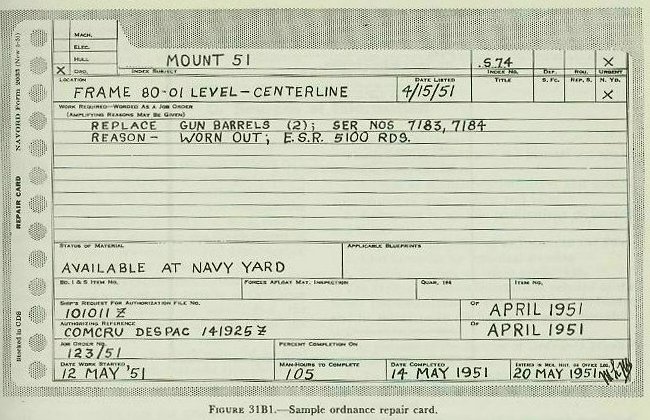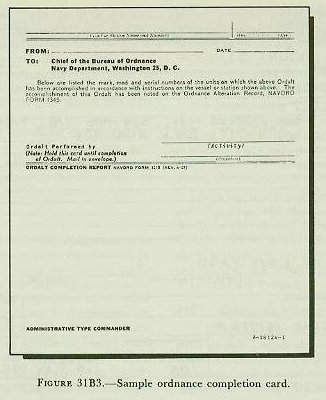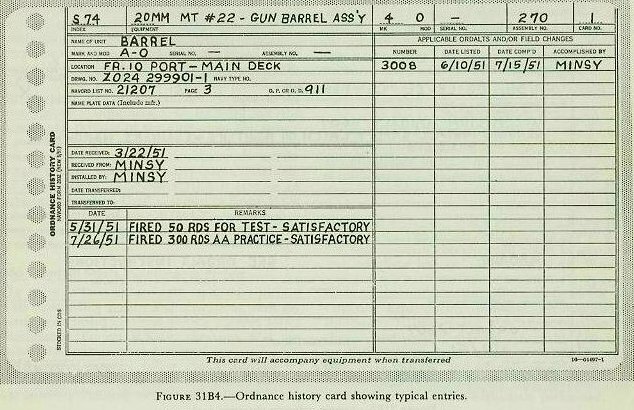| NAVAL ORDNANCE AND GUNNERY VOLUME 2, FIRE CONTROL CHAPTER 31 JUNIOR GUNNERY OFFICER |
| HOME INDEX Chapter 31 Junior gunnery officer A. Gunnery department B. Administrative duties C. Sources of information D. Gunnery exercises |
| B. Administrative Duties 31B1. General First of all, the junior gunnery officer will find himself confronted with what appears to be an intricate maze of administrative details. He will have inspections, tests, and checks to be made on various pieces of ordnance equipment; he will have inventories to take and spare parts and gear to order; he will have seemingly endless reports to make; he will have countless little problems within his division which require solution. Moreover, he will have watches to stand, logs to write, and will probably have one or more collateral duties not necessarily related to Gunnery Department work. All this will be in addition to his primary duty of developing and maintaining that part of the ship’s armament for which he is responsible to the highest degree of readiness as regards both personnel and material. A junior officer assigned to the Gunnery Department will be further assigned to a gunnery division and consequently should be familiar with the duties of a Gunnery Department division officer. Gunnery Department division officers are governed by Navy Regulations and the Ship’s Organization Book. Division Officer’s Guide contains a summary of what must be accomplished in the organization, training, and direction of a ship’s division, and is a useful guide to the leadership aspect of the division officer’s duties. In addition to the responsibilities and duties prescribed in Navy Regulations, Gunnery Department officers, under the Gunnery Officer, are responsible for the proper performance of the following functions: 1. Ensuring, through a properly conducted training program, that all personnel of the division are properly trained in their duties and ready for action. 2. Ensuring that all spaces and equipment assigned to the division are maintained in the required condition of upkeep and cleanliness. 3. Ensuring that all division personnel are thoroughly instructed in pertinent safety precautions. This responsibility does not end with the publication of safety precautions; the division officer must also ensure that all safety precautions are carried out both in spirit and to the letter. 4. Informing the Gunnery Officer of any conditions in the division that may decrease efficiency of division personnel or equipment, particularly if any ordnance equipment in the division is, for any reason, not ready for battle. Division officers are assigned additional duties pertaining to the specific assignment of their divisions in the Ship’s Organization Book, or as the Gunnery Officer may see fit. Each junior division officer is required to be thoroughly familiar with all duties, responsibilities, and activities of his division. In addition, each junior division officer is assigned certain specific duties for which he is responsible to the division officer. 31B2. Training No single function is more important than the training of personnel. The most expensive and best designed equipment is useless unless the men stationed at it know how to maintain and operate it intelligently. Training starts at the lowest level. It must be a continuous, progressive process, objectively designed to produce realistic problems and conditions, and intelligently handled to create and maintain enthusiastic interest. As one of the duties of the Gunnery Officer is the supervision and direction of the employment of ordnance equipment, so is it the junior officer’s duty to implement this program by proper training of personnel. There are several requisites for an effective training program. The junior officer must be completely familiar with the ordnance equipment for which he is responsible. This includes not only operating procedures, but theory and design characteristics as well. He must ensure that petty officers and key personnel, who will conduct instruction on station, are themselves competent and well informed. The junior officer must carefully appraise his men and assign them stations in accordance with their capabilities, both mental and physical. Frequently, valuable information can be obtained from the service record of each man, which is available in the Executive Officer’s office. A division notebook, which should contain detailed data on each man in the division, as well as the division station bill and battle bill, is invaluable in this instance. Finally, the junior officer cannot neglect his own training. He must apply himself continually and learn not only his job but the jobs of those who are immediately senior to him. When the time comes for fleeting up, he must be ready. He must also learn how his division fits into the Gunnery Department and in turn how that department functions in the ship’s organization. 31B3. Material maintenance Just as important as the training of personnel to operate ordnance equipment, is the proper maintenance of that equipment, so that it will be serviceable when needed. Modern ordnance equipment is extremely complex and requires constant check, test, lubrication, and adjustment to keep it in first-class operating condition. Much of this routine, day-to-day, week-to-week work can be called “preventive maintenance”-in other words, attempts to discover and eliminate possible sources of trouble before trouble actually occurs. The Bureau of Ordnance furnishes, with each ordnance installation, Publications which outline maintenance procedures. These publications are readily available, but it is the junior officer’s responsibility to see that the procedures outlined in them are followed by the gunners’ mates and fire control technicians. Frequently, Type Commanders will issue check-off lists which detail the items of work that are to be done daily, weekly, monthly, etc. As work logs are kept on each piece of ordnance equipment, the junior officer can quickly check the work accomplished each week. He should not, however, be satisfied with paper-work checks. The junior officer should get around his spaces during working hours, find out what his men are doing, what items or pieces of gear are troublesome, and what can be done to overcome the difficulties. He can also learn much about his equipment if he is present while checks, tests, cleaning, and lubrication, are going on. 31B4. Repairs Casualties will occasionally occur even to the best equipment, thus necessitating repairs. A repair is defined by Navy Regulations as “work necessary to restore a ship or article to serviceable condition without change in design, materials, number, location, or relationship of the component parts.” Repairs are divided into three classes according to the agency performing them: i. e., ship’s force, repair ship, or naval shipyard. Quite naturally, the extent of repairs that can be accomplished by ship’s force on small ships is limited by a lack of facilities and personnel. A repair ship has more elaborate repair facilities and personnel experienced in repair work, and can accomplish most work not of a major nature. The naval shipyard, of course, is capable of handling any major repair item. An Ordnance Repair Card, such as the one shown in figure 31B1, is used to facilitate the accomplishment of repairs. The general class “repairs” also includes the “alteration equivalent to repair.” This type of work item includes the substitution of a slightly different article or material for one which must in any case be repaired or replaced as a consequence of damage or wear. The definition of “alteration equivalent to repair” is a very narrow one and should never be used to obtain improved equipment in place of older equipment which is still in usable condition. |
 |
| 31B5. Alterations An alteration is defined by Navy Regulations as “any change in the hull, machinery, equipment, or fittings which involves a change in design, materials, number, location, or relationship of the component parts of an assembly regardless of whether it is undertaken separately from, or incidental to, or in conjunction with, repairs.” No alteration shall be made to any ship or article on board until specifically authorized by the Bureau concerned. Alterations of such extent as materially to modify the military characteristics of a ship may be authorized only by the Chief of Naval Operations. When so authorized, they are issued by the Bureau of Ordnance or such other technical bureau as may have cognizance of the material concerned, as serially numbered NAVALTS. Other authorized alterations to ordnance equipment are issued by the Bureau of Ordnance as serially numbered ORDALTS. Both NAVALTS and ORDALTS contain complete descriptions of the changes to be accomplished. Information is included on the purpose and priority of the alteration; the agency to perform it; the procurement of material; the disposition of discarded material, if any; the weight change, if any; and all necessary plans, diagrams, and specifications. The information is filed on an Ordnance Alteration Card as shown in figure 31B2. Upon completion of an ORDALT, an Ordnance Completion Card (fig. 31B3) is forwarded to the proper commands. |
 |
 |
| 31B6. Current Ship’s Maintenance Project In order to have an accurate, up-to-date picture of all outstanding repairs and alterations, each department on board ship maintains a Current Ship’s Maintenance Project (CSMP). Separate files are maintained for repairs and alterations. The junior gunnery officer should become familiar with the CSMP as soon as possible, and see that entries pertaining to equipment for which he is responsible are promptly made. Whenever a piece of equipment requires repair, a complete brief of the existing condition should be drawn up, including an analysis of the deficiency and an estimate of the work necessary to restore the article to serviceable condition. All outstanding applicable alterations are also listed in the Alteration and Improvement Program (A and I Program) which serves as a ready summary for administration purposes. This program does not include the same amount of technical detail about the alterations as does the CSMP. Likewise, when authorizations for alterations are received from the Bureau, prompt entry should be made in the A and I Program and the alteration CSMP. Thus, when a ship is scheduled for repair-ship availability or shipyard overhaul, work lists can be quickly compiled from the Current Ship’s Maintenance Project. |
| 31B7. Ordnance History A complete record for each piece of equipment with its mark, mod, serial number, name-plate data, and all casualties, repairs, and alterations thereto must be kept by the Gunnery Officer. Thus the maintenance and alteration status of the various batteries can be determined easily by examining the record. This record is called the Ordnance History (fig. 31B4). The junior officer will find that it is his responsibility to keep up this record for all equipment which falls under his personal cognizance. The form for this record varies with different ships, and the new officer must acquaint himself with the type used in the Gunnery Department on his ship. Most of the information which is entered into the machinery history is obtained from the battery and fire control logs. Battery logs, which are usually maintained by the senior petty officer in charge of each type of equipment, under the direct and close supervision of the division officers, show the work accomplished on the equipment, test results, alignment data, etc. It is a painstaking task to ensure that the logs are properly kept up day by day, but only constant checking will result in a proper and complete history. Such entries as “routine tests carried out” are better avoided. It is especially important that logs and records should be carefully kept during overhaul periods (when equipment is undergoing the largest number of changes and repairs), even though at this time it is most difficult to do so. Such occasions coincide with leave periods, and officers remaining aboard double up to cover all billets, with the result that some duties may not be adequately performed. OP 1887 sets forth the detailed procedure for maintaining all essential gunnery records, and all officers assigned to gunnery duties must become thoroughly conversant with this publication. While studying OP 1887 one should pay particular attention to the function of each log and record rather than to its form, for the forms are standardized and are readily available on board all ships. |
 |